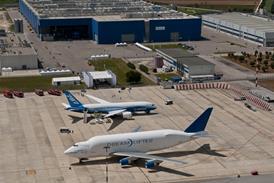The first two Galileo satellites launched on 21 October are well into their early orbit preparation phase, spearheading the deployment of a global navigation satellite system essential to the success of the more advanced stages of the Single European Sky.
The two satellites and the complex ground support network integral to their operation are now entering the system's first validation phase, known as Galileo in-orbit validation (GIOVE). During this first phase, two more Galileo satellites will be launched in mid-2012 to join the two experimental satellites - GIOVE-A and GIOVE-B - in orbit.
The IOV is the first step in a staggered process leading to full operational capability, planned for 2019, when the complete 30-satellite constellation and a set of remote terrestrial stations distributed worldwide will start to deliver super-accurate navigation and timing co-ordination services to both aviation and surface users.
Meanwhile, initial services will be delivered by the four IOV satellites and, gradually, the 14 more that have already been ordered to date. These 18 Galileo satellites will be in space by about 2014.
The two newly-launched satellites are currently being prepared for useful operation. On 21 October, separation from the Soyuz launch vehicle started the "launch and early orbit phase" (LEOP). During LEOP, spacecraft carry out a series of automated and then terrestrially commanded actions, including deployment of solar arrays to obtain power, switching on communications and other systems, and setting initial configurations.
Programmed to take about seven days, the Galileo LEOP is overseen by a team of mission specialists from The European Space Agency and the French CNES, based at the Centre Spatial de Toulouse, which uses datalinks to the ground stations that communicate with the satellites.
They exercise mission control and monitor onboard systems, flight dynamics and telecommunications.
When LEOP is complete, the satellites will be handed over to the Oberpfaffenhofen Galileo Control Centre, operated by the DLR German Aerospace Centre, responsible for routine operations.
The GNSS functions for aviation and terrestrial users will be managed by the Fucino Control Centre, near Rome. Operated by Telespazio, Fucino was set up at the end of 2010 specifically for this purpose. Its responsibilities include generating navigation and integrity messages to embed within Galileo signals - essential to guarantee positioning, velocity and timing accuracy.
Eurocontrol, meanwhile, defines the aviation requirements Galileo must meet. The new GNSS constellation, along with existing ones such as GPS and Glonass, will be critical to provide precise positioning and timing information to synchronise ground systems, onboard equipment, communication networks and operations.
The agency explained: "It is a central enabler for multiple applications. It is a technical cornerstone for performance-based navigation and for the future automatic dependent surveillance - broadcast (ADS-B) surveillance systems.
"It will also be used as a precision navigation aid for landing, and for sense/detect-and-avoid systems for unmanned air vehicles."
Source: Flight International


























